Think email marketing is dead?
Think again.. Email marketing is actually thriving.
In HubSpot’s 2020 State of Marketing Report, roughly 80% of marketers said their brand’s email engagement had improved in the last year. Our researchers also discovered that brands make an average of $42 for every dollar spent on email advertising.
mail marketing is still widely used and continues to offer many benefits to marketers. It can boost brand awareness, increase web traffic, delight your audience, and ease subscribers through the customer funnel.
While email marketing isn’t a new strategy,, many marketers still struggle to grow and maintain the size of their subscriber lists.
But you shouldn’t throw in the towel if you’re struggling to build your list of contacts. Like any great marketing strategy, you’ll need to get in the mindset of your customers to determine why they’re likely to subscribe — or unsubscribe — from your email list.
To help you think like your subscribers, I polled 400 consumers to ask them about why they’ve joined or removed themselves from marketing email lists in the past. Here’s what they said.
Why Consumers Subscribe to Marketing Emails
The first question I asked consumers was, “Why do you most commonly subscribe to marketing emails or email newsletters?”
It’s apparent that consumers sign up for emails that provide direct value to them.
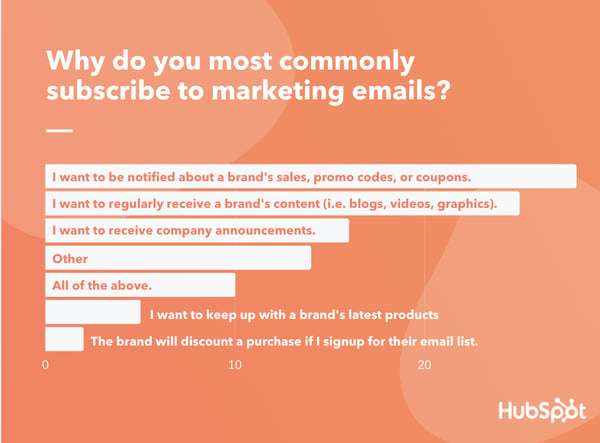
Below is a quick breakdown of what each result means for marketers, as well as examples of effective emails that leveraged their audience interests.
1. Deals, Discount Promo Codes, and Coupons
Roughly 28% of consumers say they subscribe to branded emails because they “want to be notified about sales, promo codes, or coupons from a company.”
It’s not shocking that emails promoting deals and sales are the top preference of consumers. By now, many of us have either subscribed to an email like this for personal use, or skimmed our inbox looking for promo codes before a big shop.
Although these emails are primarily for announcing deals or ways that your prospect can save money, you can still also use them for other promotions. For example, while prioritizing a sale, deal, or coupon code at the top of the email, you can also share news about a new product or blog posts at the bottom. Just keep in mind that your subscribers signed up to get the best bang for their buck, then continue to come up with ways to delight them.
Here’s a great example. When you subscribe to Postmates, you can ask to receive emails with promotions and coupons. Once subscribed, Postmates will send you semi-regular coupon codes and news about restaurant-specific sales:
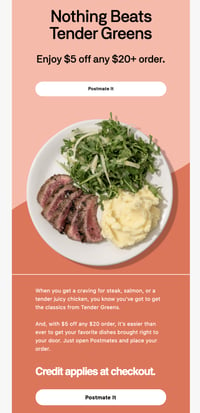
As a subscriber, I personally love the Postmates email because it stands by its mission to send me discount information. Whenever I consider ordering in, I search through my inbox to see if they sent any promo codes recently. When they do, I don’t hesitate to get my meal delivery from this app over other competitors.
2. Links to Valuable Content From the Brand
Not all audiences are looking to get the latest deals on products. Sometimes, people subscribe to emails just for the sake of learning new things. This explains why one-quarter of participants say they subscribe to emails because they want to regularly receive “a brand’s content (i.e. blogs, videos, graphics).”
Although creating an email for your blog posts or branded content might not seem like it will benefit purchases or ROI directly, these types of emails still offer a number of benefits that can impact the bottom line.
For example, those who subscribe will get to see content from you that demonstrates why your brand is a trusted voice in your industry. After seeing and consuming valuable content from you regularly, your company could be the first that comes to mind when a subscriber needs to purchase a product that you sell.
Additionally, although content-based emails might not focus on promotions, this doesn’t mean you can’t include one within the mix of links shared in an email. Aside from subtly including promotions in one of these emails, you could also link to blog or video content aimed at lead generation.
To give you an example of a content-based marketing email, take a look at HubSpot’s Service Blog email. Each day, the Service Blog sends the posts that were published the same day to subscribers. While the content is mostly informative, we occasionally mix in other promotions, such as the call-to-action to visit our new Website Blog.
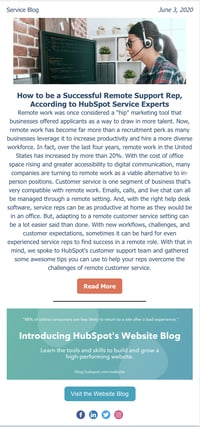
3. Company Announcements
A number of brands choose to use their emails to show audiences the inner-workings of their company. These emails might include press release-styled announcements, information about the staff, or posts from the company’s corporate blog.
While this content might not directly value audiences as much as coupons or educational content, it still helps brands to establish themselves as credible and successful to audiences who are interested in watching them grow. This might be why 16% of those I polled subscribe purely to get company-specific announcements in their inbox.
4. Mixes of Content, Promotion, and Company News
While 10% of participants selected “All of the above” as their primary email subscription reasoning, 14% chose “Other.” These results might hint that groups of email subscribers might enjoy different types of content in one email.
As you get to know your email audience, center your emails around the content you promised email recipients on their subscriber form. But, consider including one or two promotions that break your usual email norm to see if you can diversify your emails a bit more.
For example, if you have an audience subscribed to your company blog’s email, consider subtly including a coupon or discount at the bottom — after your blog content — to see if you can gain conversions.
5. Other Reasons
Interestingly, only 5% of consumers said they commonly sign up for emails to learn about new products from a brand. Additionally, although many companies will offer discounts when consumers sign up for their email newsletter, just 2% say they sign up for emails primarily for these tactics.
Although the minority of participants chose the options listed above, you might still want to consider experimenting with them in case they work for you, or your audience prefers a mix of content.
Why Consumers Unsubscribe to Marketing Emails
Once marketers build out their email list, the next challenge they’ll face is maintaining it.
And, sometimes, even if you have great email engagement or a winning formula for email success, you’ll see a random dip in subscribers. \
Why could this be? Have people gotten bored with your content? Have they found another competing brand with a better newsletter? Are they just over email altogether?
The truth is, a bump in your unsubscribe rate could be due to super simple — and easily fixable — logistical reasons.
When I asked consumers, “What’s the most common reason why you unsubscribe from marketing emails?” most participants sighted reasons other than the quality of email content.
In fact, 51% say they unsubscribe because “emails come too often.”
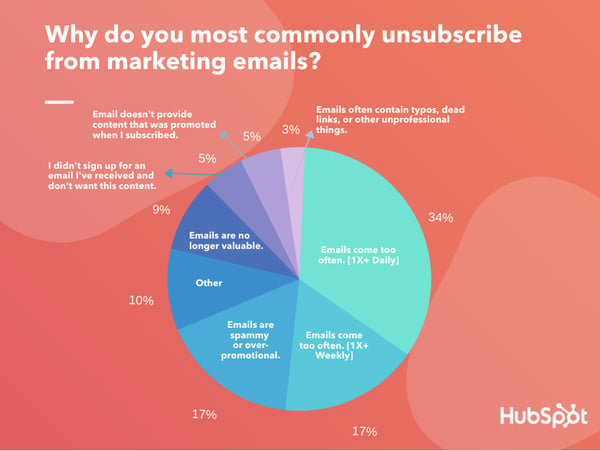
Below, I’ll explain what frequency-related unsubscriptions mean for email marketers, as well as break down some of the other major subscription barriers.
1. Email Frequency
While 34% of those surveyed say they most commonly unsubscribe from email lists because “emails come too often. [More than once per day.],” 17% say, “Emails come too often. [More than once per week.]
Despite stats like those above, and the fear that too many emails will result in high unsubscribe rates, most marketers still send multiple weekly and daily emails. According to our State of Marketing Report, more than 50% of marketers send emails between three and eight times per week.
So, how do you stick to an effective email cadence without losing subscribers? Keep reading to learn about a few preventative measures.
Preventing Frequency-Related Unsubscription
If your audience begins to cite frequency as a reason for unsubscribing, or you suspect you might be sending too many emails based on the lower click or open rates throughout the week, consider dropping one to two of your regular emails, or combining two emails scheduled for the same day.
Once you consolidate your emails, see if your unsubscription or spam rates lower, while paying attention increases in engagement metrics like open rate or click-through rates. If you see your metrics fluctuate for the better, you might want to identify more ways to consolidate your brand’s email.
If you absolutely can’t consolidate your emails, make sure that you’re transparent about how many you’ll be sending subscribers on your subscribe form. This will ensure that all subscribers know what type of content and email frequency they’re signing up for upfront and might weed out audiences who will quickly unsubscribe.
2. Low-Value Content
Although content isn’t the biggest driver of unsubscriptions, it still can be a factor.
While 17% of participants commonly unsubscribe from emails that feel “spammy or over promotional,” 9% will unsubscribe if the content is “no longer valuable.”
The result above isn’t that surprising. When’s the last time you unsubscribed from an email that you used to love getting in your inbox?
Luckily, there are a number of tactics you can try to prevent your content from getting too stale or spammy.
How to Prevent Content-Related Unsubscribes
First, do a deep dive into your email metrics.
If you’re seeing low open rates, click-through rates, high skim-to-read-rate ratios, as well as unsubscribes or spam reports related to poor content, it might be time to audit the content you’re sharing in each email, test out new types of content, and avoid any sharing things that might disengage your audience.
Along with looking at hard metrics, you should also consider the content you’re creating for your audience before you hit send. Ask yourself questions like, “Is this email valuable to my audience?”, “Does it over-promote my products?”, “Does the content in this email align with how I marketed this email subscription in the first place?”, and “Is this content on brand?”
If you have a large audience with a number of different interests. You might also worry that some audiences will love the links you’re sharing in your email while others might be interested in other topics. If that’s the case, you can also consider email segmentation.
With email segmentation, you can break your list of contacts into separate lists to ensure that people with vastly different interests are only getting sent content that will interest them.
For example, since HubSpot Blog readers are primarily interested in marketing, sales, service, or website development, we have daily and weekly email lists for each of our blog properties. This way, if you’re a marketer interested in web development, you can subscribe to our Marketing Blog and Website Blog emails without seeing Sales or Service content that relates less to your field.
3. Unexpected Promotions or Content
Along with content that isn’t valuable, 10% of participants primarily unsubscribe from emails that don’t provide content they expected to receive.
Roughly 5% of participants say they most commonly unsubscribe from emails that they “didn’t sign up for” in the first place, while another 5% says they primarily unsubscribe from emails that “don’t offer content, promotions, or coupons” that the brand described when marketing the subscription.
Avoiding Unsolicited Email Content
As an email marketer, it’s your job to understand your audience and send content they’ll engage with. Meanwhile, consumers that sign up for your email will expect you to send them the valuable content they asked for when signing up. When you blast them with emails they won’t like or didn’t ask for, they might trust your brand a little bit less.
For example, if you market a daily newsletter that promises expert tips from thought leaders, blog posts, or coupons, and instead send semi-daily newsletters that promote only products with no discounts, your audiences might not be too happy.
As you manage your email strategy, remember what you promised your subscribers when they signed up. Focus on promoting links that are valuable and align with their interests, as well as your brand.
Because consumers don’t appreciate or trust unsolicited email in their inboxes, we don’t condone purchasing contacts from another company. Not only is this against GDPR mandates, but it could also annoy contacts, cause unsubscriptions, and hurt your IP reputation.
As an alternative, consider co-branded emails. With this strategy, you can market one brand’s email subscription and content in your email while they market your email and content to their subscription list. This way, the brand’s audience can choose whether or not they want to subscribe and might be less likely to remove themselves from your list after signing up.
Here’s a great example of a co-branded email campaign from HubSpot and Unbounce. Although this doesn’t directly market HubSpot or Unbounce email subscription options, it highlights great points about both companies and a project they’re jointly working on which could indirectly result in both brands gaining email subscribers:
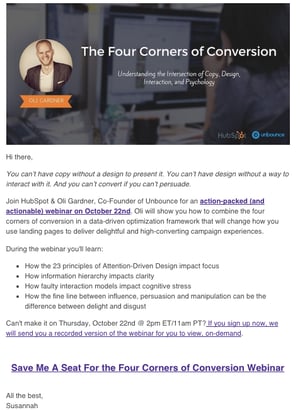
Tips for Winning (and Keeping) Email Subscribers
Email marketing best practices aren’t always the same for every brand. That means that it will take experimentation and practice to grow and maintain your email subscriber list.
Because building a list can be challenging in the beginning, it’s important to not give up when one or two tactics don’t work. Although you’ll want to personalize your tactics to your audience, here are a few overarching tips to keep in mind as you aim to grow your list.
1. Create email tactics and content that audiences will value.
First, and most importantly, you’ll want to develop and execute on an email strategy that prioritizes valuable content and avoids over-promotion.
For example, you could create an email with a mix of sales, coupons, and promo codes, or focus on promoting your most engaging blog posts. Or, if you have a giant audience with a few key interests, you could segment them by creating separate marketing emails and subscriber lists.
2. Market the most valuable aspects of your brand’s email.
To get people to actually see your valuable email content, you’ll need to market it in order to get subscribers. When you share your email subscription form on your site or social media, point out what your emails will provide to your audience. Will they include blog content, expert tips related to your industry, or special deals? If so, clearly state this in your messaging.
Here’s a look at how we promote the HubSpot Blog’s emails:
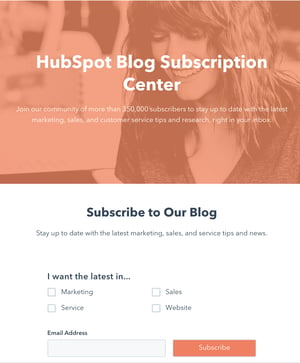
3. Don’t just focus on just your products.
Yes. You are a marketer and shouldn’t avoid talking about great product offerings when you have them. However, too many product details in an email can feel spammy or over promotional.
When you promote your products in an email, try to include other content, such as links to blogs or videos to balance the email out. This will be even more important if you promoted valuable content rather than just product news when marketing your email subscription form.
In our 2020 State of Marketing Report, EMEA marketing manager Henni Roini emphasized why product promotion isn’t everything.
“Only the companies and brands that create human connection are going to succeed. This is extremely true with email. You might get short term benefits from very promotional content, but honest, human, and personalized content creates a following for the long term,” Roini said.
Want to learn more about email marketing? Here’s a guide on how to use email marketing to guide your prospect through the buyer’s journey. More interested in diving into email data? Check out this list of helpful email marketing stats.
![]()
Original Entry: Why Consumers Subscribe and Unsubscribe from Email [New Data] is shared from https://blog.hubspot.com/marketing/why-consumers-subscribe-to-email via https://blog.hubspot.com/marketing
Check out the original post, Why Consumers Subscribe and Unsubscribe from Email [New Data] that is shared from https://putyourfamilyfirst.wordpress.com/2020/07/06/why-consumers-subscribe-and-unsubscribe-from-email-new-data/ via https://putyourfamilyfirst.wordpress.com
No comments:
Post a Comment